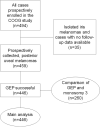Collaborative Ocular Oncology Group report number 1: prospective validation of a multi-gene prognostic assay in uveal melanoma
- PMID: 22521086
- PMCID: PMC3404209
- DOI: 10.1016/j.ophtha.2012.02.017
Collaborative Ocular Oncology Group report number 1: prospective validation of a multi-gene prognostic assay in uveal melanoma
Abstract
Purpose: This study evaluates the prognostic performance of a 15 gene expression profiling (GEP) assay that assigns primary posterior uveal melanomas to prognostic subgroups: class 1 (low metastatic risk) and class 2 (high metastatic risk).
Design: Prospective, multicenter study.
Participants: A total of 459 patients with posterior uveal melanoma were enrolled from 12 independent centers.
Testing: Tumors were classified by GEP as class 1 or class 2. The first 260 samples were also analyzed for chromosome 3 status using a single nucleotide polymorphism assay. Net reclassification improvement analysis was performed to compare the prognostic accuracy of GEP with the 7th edition clinical Tumor-Node-Metastasis (TNM) classification and chromosome 3 status.
Main outcome measures: Patients were managed for their primary tumor and monitored for metastasis.
Results: The GEP assay successfully classified 446 of 459 cases (97.2%). The GEP was class 1 in 276 cases (61.9%) and class 2 in 170 cases (38.1%). Median follow-up was 17.4 months (mean, 18.0 months). Metastasis was detected in 3 class 1 cases (1.1%) and 44 class 2 cases (25.9%) (log-rank test, P<10(-14)). Although there was an association between GEP class 2 and monosomy 3 (Fisher exact test, P<0.0001), 54 of 260 tumors (20.8%) were discordant for GEP and chromosome 3 status, among which GEP demonstrated superior prognostic accuracy (log-rank test, P = 0.0001). By using multivariate Cox modeling, GEP class had a stronger independent association with metastasis than any other prognostic factor (P<0.0001). Chromosome 3 status did not contribute additional prognostic information that was independent of GEP (P = 0.2). At 3 years follow-up, the net reclassification improvement of GEP over TNM classification was 0.43 (P = 0.001) and 0.38 (P = 0.004) over chromosome 3 status.
Conclusions: The GEP assay had a high technical success rate and was the most accurate prognostic marker among all of the factors analyzed. The GEP provided a highly significant improvement in prognostic accuracy over clinical TNM classification and chromosome 3 status. Chromosome 3 status did not provide prognostic information that was independent of GEP.
Copyright © 2012 American Academy of Ophthalmology. Published by Elsevier Inc. All rights reserved.
Figures



Comment in
-
Gene expression profiling versus TNM classification.Ophthalmology. 2013 May;120(5):1109.e1. doi: 10.1016/j.ophtha.2012.12.019. Ophthalmology. 2013. PMID: 23642753 No abstract available.
-
Molecular analysis of uveal melanoma.Ophthalmology. 2013 Jul;120(7):e50. doi: 10.1016/j.ophtha.2013.03.036. Ophthalmology. 2013. PMID: 23823528 No abstract available.
-
Author reply: To PMID 22521086.Ophthalmology. 2013 Jul;120(7):e51. doi: 10.1016/j.ophtha.2013.03.037. Ophthalmology. 2013. PMID: 23823529 No abstract available.
-
Gene expression profiling versus TNM classification.Ophthalmology. 2013 Jul;120(7):e52-3. doi: 10.1016/j.ophtha.2013.03.011. Ophthalmology. 2013. PMID: 23823531 No abstract available.
References
-
- Ramaiya KJ, Harbour JW. Current management of uveal melanoma. Expert Rev Ophthalmol. 2007;2:939–46.
-
- Singh AD, Turell ME, Topham AK. Uveal melanoma: trends in incidence, treatment, and survival. Ophthalmology. 2011;118:1881–5. - PubMed
-
- Eskelin S, Pyrhonen S, Summanen P, et al. Tumor doubling times in metastatic malignant melanoma of the uvea: tumor progression before and after treatment. Ophthalmology. 2000;107:1443–9. - PubMed
-
- Augsburger JJ, Correa ZM, Shaikh AH. Effectiveness of treatments for metastatic uveal melanoma. Am J Ophthalmol. 2009;148:119–27. - PubMed
Publication types
MeSH terms
Substances
Grants and funding
LinkOut - more resources
Full Text Sources
Other Literature Sources
Medical

